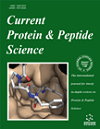- Home
- A-Z Publications
- Current Protein and Peptide Science
- Previous Issues
- Volume 4, Issue 2, 2003
Current Protein and Peptide Science - Volume 4, Issue 2, 2003
Volume 4, Issue 2, 2003
-
-
Structural Variety of Membrane Permeable Peptides
More LessAuthors: S. Futaki, S. Goto, T. Suzuki, I. Nakase and Y. SugiuraPeptide-mediated protein delivery into living cells has been attracting our attention. Among the peptides that have been reported to have carrier activity, the one from the human immunodeficient virus (HIV)-1 Tat has been most often used for the introduction of exogenous macromolecules into cells. We have shown that not only the Tat peptide, but also various arginine-rich peptides showed very similar characteristics in tran Read More
-
-
-
Modulation of Cellular Function by TAT Mediated Transduction of Full Length Proteins
More LessAuthors: J.S. Wadia and S.F. DowdyDue to the barrier imposed by the cell membrane, delivery of macromolecules in excess of 500 Daltons directly into cells remains problematic. However, proteins, which have been evolutionarily selected to perform specific functions, are therefore an attractive therapeutic agent to treat a variety of human diseases. In practice, the direct intracellular delivery of these proteins has, until recently, been difficult to achieve due Read More
-
-
-
Guanidinium Rich Peptide Transporters and Drug Delivery
More LessAuthors: L.R. Wright, J.B. Rothbard and P.A. WenderThe use of peptide or peptidomimetic transporters to enable or enhance the uptake of drugs or probe molecules into cells and tissues has received increasing research attention and clinical interest over the past 10 years. This review summarizes a class of transporters that have been studied and focuses on the variation and use of guanidinium based transporters to facilitate the uptake of various types of molecules into cells a Read More
-
-
-
TAT Peptide Internalization: Seeking the Mechanism of Entry
More LessAuthors: E. Vives, J. Richard, C. Rispal and B. LebleuDuring the last decade several peptides have been extensively studied for their ability to translocate across the plasma membrane. These peptides have been called “cell penetrating peptides” (CPP) or “protein transduction domains” (PTD). These peptides also promote the cellular uptake of various cargo molecules. Their mechanism of cellular entry appeared very intriguing since most publications in the field highlighted an e Read More
-
-
-
TAT-Liposomes: A Novel Intracellular Drug Carrier
More LessAuthors: V.P. Torchilin and T.S. LevchenkoTAT peptide was attached to the surface of plain and PEGylated liposomes. These TAT peptide-modified liposomes have been shown to translocate into a variety of normal and cancer cells if a non-hindered interaction between the cell surface and liposome-attached TAT peptide was made possible. TAT peptide-liposomes translocated into cells remain intact within first few hours as proved by a co-localization of fluorescent Read More
-
-
-
Basic Peptides as Functional Components of Non-viral Gene Transfer Vehicles
More LessAuthors: M. Nakanishi, A. Eguchi, T. Akuta, E. Nagoshi, S. Fujita, J. Okabe, T. Senda and M. HasegawaImproving the performance of non-viral gene-delivery vehicles that consist of synthetic compounds and nucleic acids is a key to successful gene therapy. Supplementing synthetic vehicles with various biological functions by using natural or artificial peptides is a promising approach with which to achieve this goal. One of the obstacles hindering this effort is that some of the potentially useful peptides, especially those with many Read More
-
-
-
Protein Therapy: In Vivo Protein Transduction by Polyarginine (11R) PTD and Subcellular Targeting Delivery
More LessAuthors: H. Matsui, K. Tomizawa, Y-F. Lu and M. MatsushitaProtein Therapy is a newly developed method, which allows proteins, peptides and biologically active compounds to penetrate across the plasma membrane of eukaryotic cells by a polyarginine (most efficiently by 11-arginine, 11R) protein transduction domain [1]. This method enables us to control the localization of targeted substances in subcellular compartments, such as the nuclei, mitochondria and post-synaptic density. Read More
-
Volumes & issues
-
Volume 26 (2025)
-
Volume 25 (2024)
-
Volume 24 (2023)
-
Volume 23 (2022)
-
Volume 22 (2021)
-
Volume 21 (2020)
-
Volume 20 (2019)
-
Volume 19 (2018)
-
Volume 18 (2017)
-
Volume 17 (2016)
-
Volume 16 (2015)
-
Volume 15 (2014)
-
Volume 14 (2013)
-
Volume 13 (2012)
-
Volume 12 (2011)
-
Volume 11 (2010)
-
Volume 10 (2009)
-
Volume 9 (2008)
-
Volume 8 (2007)
-
Volume 7 (2006)
-
Volume 6 (2005)
-
Volume 5 (2004)
-
Volume 4 (2003)
-
Volume 3 (2002)
-
Volume 2 (2001)
-
Volume 1 (2000)
Most Read This Month
Article
content/journals/cpps
Journal
10
5
false
en


